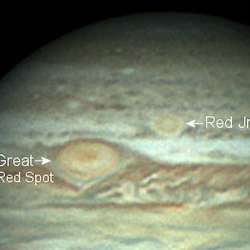
Jupiter’s two red spots. Image credit: Christopher Go. Click to enlarge
Jupiter’s well known Great Red Spot storm, and its newly formed Oval BA (aka Red Jr.) are about to sweep past each other, and astronomers aren’t quite sure what’s going to happen. The storms probably won’t merge or tear each other apart, but their outer bands will rub against each other. Oval BA recently turned red, signifying its larger size and strength compared to the smaller white storms on Jupiter. Some astronomers think the encounter with the Great Red Spot will slow it down again, returning it to white.
The two biggest storms in the solar system are about to go bump in the night, in plain view of backyard telescopes.
Storm #1 is the Great Red Spot, twice as wide as Earth itself, with winds blowing 350 mph. The behemoth has been spinning around Jupiter for hundreds of years.
Storm #2 is Oval BA, also known as “Red Jr.,” a youngster of a storm only six years old. Compared to the Great Red Spot, Red Jr. is half-sized, able to swallow Earth merely once, but it blows just as hard as its older cousin.
The two are converging. Closest approach: the 4th of July, according to Amy Simon-Miller of the Goddard Space Flight Center who has been monitoring the storms using the Hubble Space Telescope.
“There won’t be a head-on collision,” she says. “The Great Red Spot is not going to ‘eat’ Oval BA or anything like that.” But the storms’ outer bands will pass quite close to one another-and no one knows exactly what will happen.
Amateur astronomers are already monitoring the event. Christopher Go of the Philippines took the picture above using his 11-inch telescope on May 28th. “The distance between the storms is shrinking visibly every night,” he says.
Similar encounters have happened before, notes JPL’s Glenn Or ton, a colleague of Simon-Miller. “Oval BA and the Great Red Spot pass each other approximately every two years.” Previous encounters in 2002 and 2004 were anti-climatic. Aside from some “roughing” around the edges, both storms survived apparently unaltered.
This time might be different. Simon-Miller and Orton think Red Jr. could lose its red color, ironically, by passing too close to the Great Red Spot.
Red Jr./Oval BA wasn’t always red. For five years, 2000 to 2005, the storm was pure white like many other small “white ovals” circling the planet. In 2006 astronomers noticed a change: a red vortex formed inside the storm, the same color as the powerful Great Red Spot. This was a sign, researchers believed, that Oval BA was intensifying.
The color of the Great Red Spot itself is a mystery. A popular theory holds that the storm dredges up material from deep inside Jupiter’s atmosphere, lifting it above the highest clouds where solar ultraviolet rays turn “chromophores” (color-changing compounds) red. A beefed-up Oval BA could suddenly do the same.
Bumping up against the Great Red Spot, however, could weaken Oval BA, turning it white again. Simon-Miller explains: “We believe the Great Red Spot will push Oval BA toward a southern jet stream, which is blowing against the oval’s counterclockwise rotation.” This would slow Oval BA’s spin, possibly reversing the process that reddened it in the first place.
What will actually happen? “We’ll see,” she says. That’s what telescopes are for.
Note to sky watchers: Jupiter is easy to find. It pops out of the evening twilight before any other star, surprisingly bright. Look for it halfway up the southeastern sky at sunset: sky map.
Original Source: NASA News Release

I can tell that this is not the first time at all that you write about the topic. Why have you chosen it again?